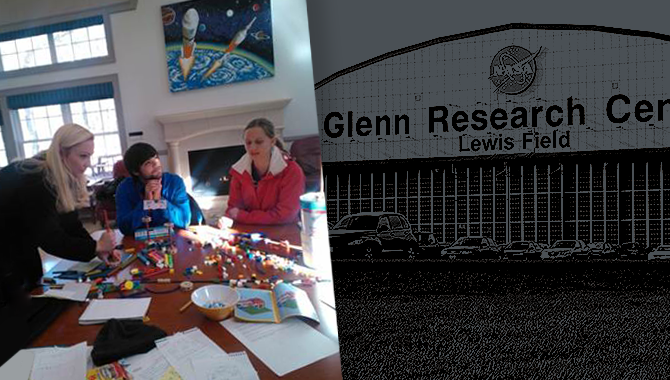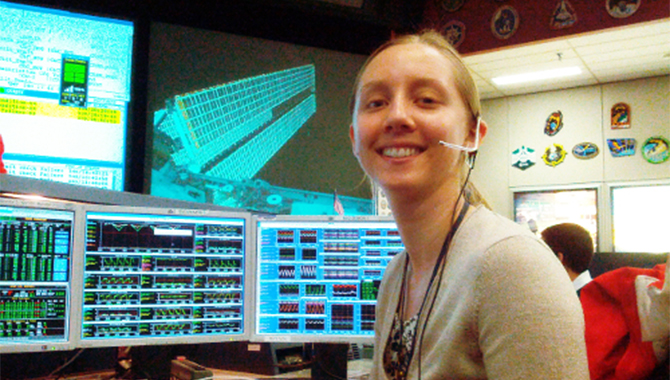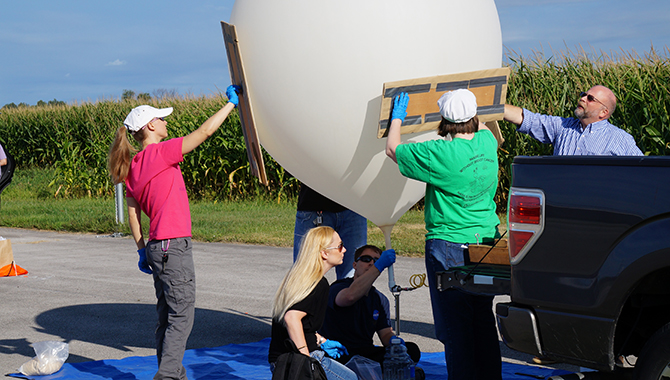
Jeffrey Chin, a member of GRC’s Rocket University pilot program, works on a Thunderbird. Chin works in Glenn’s Propulsion Systems Analysis Branch, where he develops modeling tools at a conceptual level for aircraft engines.
Photo Credit: Amanda Stevenson
Glenn Research Center’s (GRC) Rocket University reached the height of success with its pilot program and the Autonomously Navigated parGliding Experimental Lander (ANGEL) project.
Launched in 2013, GRC’s Rocket University (“Rocket U”) program was designed to give early-career employees hands-on experience through the full life cycle of a flight project. Over the course of the two-year pilot program, Rocket U participants supported their center by testing a guided position aerial delivery system that, if proven successful, would increase the reusability of high-altitude balloon gondolas.
On September 4, 2015, the team launched the ANGEL experiment from Fort Sumner, NM, to demonstrate the controlled descent of a high-altitude balloon payload to a predetermined landing site. The payload ascended into the upper atmosphere to 120,000 feet before disconnecting from the balloon. It was then guided to the desired landing site by a paragliding parachute. ANGEL demonstrated how the Airborne Systems, Inc. Guided Precision Aerial Delivery System (GPADS) can benefit planetary science balloon missions through a risk-reduction flight test for high-altitude balloon operations, allowing for faster and cheaper recovery as well as softer landing.
After the project’s completion, Jeffrey Chin—a Rocket U team member from Glenn’s Propulsion Systems Analysis Branch—co-wrote a paper that outlined and summarized the findings from their project. Chin presented the paper at the 2016 American Institute of Aeronautics and Astronautics SciTech Conference in San Diego, CA. He later spoke with APPEL News about the presentation at SciTech and how his experience with Rocket U supports his work at the center.
APPEL News: Can you start by telling us a bit about what you do at Glenn?
Jeffery Chin: I’m in the Propulsion Systems Analysis Branch, where we primarily develop modeling tools at a conceptual level for aircraft engines. For instance, we do thermodynamic cycle analysis. It’s mainly computer programming, so the Rocket University focus on hardware was a very big change, which was great.
APPEL News: Was that part of the reason you were interested in Rocket U? Because it would allow you to do things and learn things that you might not experience in your “day job” at Glenn?
Chin: Definitely. It gave me a chance to interact with other engineers, both young and experienced, from completely different branches, which is exposure I really like. In my branch, I work on small teams with people who have similar sorts of work styles to mine. In Rocket U, I got to see how people with completely different work styles operate. Being able to come together and work efficiently as a team was definitely a learning experience for me.
APPEL News: What other reasons did you have for participating in Rocket U?
Chin: At the time, I was deciding between doing a professional development program at NASA or pursuing my Master’s degree. It came down to the fact that I wanted very specific training for the job I have. With a Master’s degree, depending on where you go and what you study, it can be a very broad learning experience. Not all of the classes will be 100% relevant to your job. I felt that, with Rocket University, basically 100% of what I’d be doing—the work involved and all the time I’d be investing—would help further my career. And since it was a pilot program, I wasn’t sure how long the window of opportunity would be open for something like Rocket University, while universities—and a Master’s degree—will always be there in the future. So I jumped on the opportunity to do Rocket University when it came up.
APPEL News: In what ways did you benefit from the program?
Chin: I definitely learned a lot from a technical standpoint in addition to having a lot of soft skill experiences. And I feel like my network at the center is much stronger now. One of the best payoffs is that what I learned at Rocket University is supporting what I’m doing now. I’m trying to put together some of my own research here at NASA, and because of Rocket University I have a better understanding of how the hardware life cycle works for NASA-related projects. So as I try to sell my future project, I benefit from a better sense of what they’re are looking for, what types of document and processes people are already familiar with, and so hopefully I’ll be able to put together a stronger case for future work moving forward. Also, I have a much larger network of people I can talk to in terms of recruiting a team. Or if I need help with a specific discipline, I know the people around the center that I can talk to about it.
APPEL News: And what about your Rocket U project? What did your team work on?

Chin with three GRC Rocket University team members: Jeremiah McNatt, Justin Niehaus, and Amanda Stevenson. Photo Credit: Airborne Systems/Bill Gargano
Chin: When we were first looking for projects, we heard from a number of existing groups already at the center to find out what their needs were and whether there were any gaps we could fill. One project was looking for a way to increase the reusability of high-altitude balloon gondolas. They were considering one specific system called a guided precision aerial delivery system, but it had no flight heritage at NASA. So we saw that as an opportunity to do somewhat of a risk-reduction flight: basically, we’d test it out in a low-risk scenario. Over the course of Rocket U, we worked together with the Columbia Scientific Balloon Facility as the launch provider and Airborne Systems as the technology provider to put together a mission of opportunity flight in which we would test this hardware from an altitude of 100,000 feet for the first time. So our team at Glenn was responsible for helping organize launch operations and for designing the separation mechanism for releasing off of the host payload as well as a passive data acquisition for analyzing the results in the end.
APPEL News: Ultimately, did you determine that this system could provide value to future NASA missions?
Chin: Yes. We knew going in what the payoff would be if it worked, so really it was just validating that it works from those higher altitudes. Some of the design challenges that we were interested in examining were: would the parachute be able to handle the increased radiation exposure from being that high up? Would it be able to fall stably in a low, rarified atmosphere? Would the GPS/batteries/communication work at these really high altitudes? We were able to answer all of those questions positively: yes, it’s able to work in this completely novel environment.
APPEL News: You then put together a paper about your findings from the Rocket U project, is that right?
Chin: I co-wrote the paper with two other members of Rocket University, Justin Niehaus and Debra Goodenow, as well as two engineers from the Airborne Systems parachute group, Storm Dunker and David Montague. It outlines how the flight went and some of the data we gathered. We were very interested in understanding how much the payload was spinning, what the temperatures and pressures were, and how effectively it could navigate to the GPS coordinates we gave it. The paper summarizes that data and will hopefully help future missions design their experiments and payloads appropriately for this type of parachute system.
APPEL News: And you presented the paper at SciTech 2016?
Chin: Right. This was the second SciTech presentation I’ve done, so I was somewhat familiar with the process. The conference covers anything involved in aeronautics or astronautics. It’s huge. There are thousands of engineers as well as other people from academia, industry; really, everyone comes to this to talk about the work they’ve done in the past year. My session this year was on Unmanned Aerial Vehicles, so there were a few other high-altitude balloon parachute system presentations, but a lot of the other people in my session were looking at drones and other types of autonomous vehicles. There were about 30 people at my presentation, ranging from Northrup Grumman to university students working on balloon and parachute payloads.
APPEL News: What are you working on now that your Rocket U project is complete?
Chin: One of the research projects I’m interested in is the Hyperloop vehicle. Essentially, it is a new high-speed transportation concept. Although it travels at ground level, it utilizes a lot of aeronautics technologies and I think NASA would be a great leader for this emerging vehicle area. So I’m pushing to start doing a little bit more of that work during my day job. This isn’t being done at Glenn now; it would be a completely new thing.
APPEL News: You’re proposing a new project for Glenn to take on?
Chin: Yes. There are a few ways to spool up new research activities; we’re currently applying to the convergent aeronautics solutions (CAS) project. It’s brand new waters for me: I’ve never tried to spool up completely new research before. CAS itself is a relatively new program, so it’s kind of a learning experience for all of us involved. Proposing new work can be challenging, with a lot of upfront networking, business case formulation, and technical validation required. Luckily, I’m learning about all the different emerging incubation processes available at the center and gaining experience presenting to key decision makers.
APPEL News: Looking back at Rocket U, what did you get most out of the experience?
Chin: Being able to see a project through the entire life cycle. Normally, coming into a project, everything is already in place and you’re given very set tasks of things you need to finish by the end. So you might just be working on one part and you don’t even get to see the completion of the project. With the Rocket U project, we got to start from the very beginning and see it all the way through launch and landing. We got to see all of our hard work pay off in the end. Like I said, now I’m using the knowledge from that experience to support my research project goals.
____
In November 2015, two years after their Rocket U experience began, Chin and eight others graduated from the program. Following in their footsteps, the second GRC Rocket U class started training in February 2015. They are currently hard at work exploring remote sensing technology to investigate algae blooms that pollute water supplies.
Read an APPEL News article about the launch of GRC’s Rocket U pilot program.
Read an APPEL News interview with Jeff Chin and other members of GRC’s Rocket U program.
Learn more about Rocket University.









